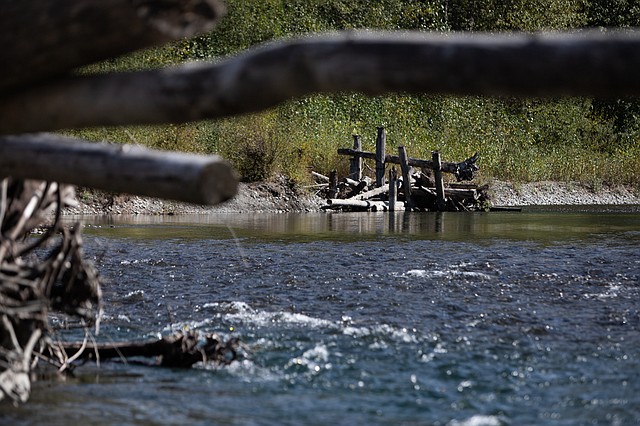Logjam construction projects along the south fork of the Nooksack River have been instrumental in supporting ongoing salmon habitat restoration, according to watershed restoration coordinators from the Nooksack Indian Tribe.
Chinook salmon are culturally significant to both the Nooksack Tribe and the Lummi Nation, though populations have fallen significantly in the last century. According to Washington’s “State of the Salmon,” Puget Sound Chinook are considered “in crisis.” Now, the tribes are working in tandem with state and local agencies to combat population loss.
“The Tribe has been a leader of salmon recovery efforts for decades,” said Treva Coe, the assistant natural resources director for the Tribe. “The Nooksack Indian Tribe is place-based, and it’s not an option to let the fish go.”
 Manmade logjams create salmon habitats along the South Fork Nooksack River. The logjams disrupt the water flow and create deep, cool pools for salmon to spawn in. (Hailey Hoffman/Cascadia Daily News)
Manmade logjams create salmon habitats along the South Fork Nooksack River. The logjams disrupt the water flow and create deep, cool pools for salmon to spawn in. (Hailey Hoffman/Cascadia Daily News)
Populations have been impacted by a variety of environmental issues, including low water flows, high water temperatures and a lack of habitat diversity. To combat these challenges, as well as ongoing issues related to climate change, the Tribe has undertaken several major restoration projects in recent years, including engineered logjam development.
“In our 22 projects, we have built a total of 367 logjams,” Coe said. “There’s been a lot invested in these projects, and we’ve done a lot of work to quantify the benefits and evaluate whether they’re effective, and we think it’s important.”
 Around two dozen people, including Wayne Drop, toured the South Fork Nooksack River to see the logjams as part of Whatcom Water Week. (Hailey Hoffman/Cascadia Daily News)
Around two dozen people, including Wayne Drop, toured the South Fork Nooksack River to see the logjams as part of Whatcom Water Week. (Hailey Hoffman/Cascadia Daily News)
Several of the manmade logjams were on display Friday for a public tour hosted by the Tribe during Whatcom Water Week.
Whatcom Water Week celebrates local water resources and restoration efforts across the county each September.
“This event is a great opportunity for the public to see some of the restoration efforts,” said Becky Peterson, the lead entity coordinator for the water resource inventory area (WRIA) that contains Whatcom County. “There’s not many opportunities for the public to come out and see these really large projects that take multiple years to put into place.”
On Friday, several watershed restoration coordinators from the Tribe showcased logjam projects along the South Fork, answering questions from public attendees and discussing ongoing salmon restoration projects.
The logjams on display were the result of a three-phase project, with construction and development occurring in 2012, 2014 and 2015, according to Eric Stover, one of the Tribe’s watershed restoration coordinators.
 A small fish swims in the calm waters created by the logjam. (Hailey Hoffman/Cascadia Daily News)
A small fish swims in the calm waters created by the logjam. (Hailey Hoffman/Cascadia Daily News)
Logjams are valuable tools for habitat restoration, as they help form pockets of deep, cool water and restore riparian forests along the banks, Stover said. That deep, cool water is vital for salmon traversing the river throughout the spawning season.
Coe compared the pockets created by logjams to “apartment complexes” for the salmon: cool temperatures, safe from predators, great for spawning.
The Tribe has plans for future logjam development, as well as other restoration projects along the Nooksack River, said Lindsie Fratus-Thomas, another watershed restoration coordinator for the Tribe.
 Ropes, chains and bolts hold together pieces of the logjam built by the Nooksack Indian Tribe. (Hailey Hoffman/Cascadia Daily News)
Ropes, chains and bolts hold together pieces of the logjam built by the Nooksack Indian Tribe. (Hailey Hoffman/Cascadia Daily News)
Despite its plans, the Tribe continues to face challenges in its habitat restoration goals.
“Landowner willingness is a huge constraint,” Fratus-Thomas said. “Salmon recovery is not only getting harder because of landowner willingness and permitting, it’s also getting more expensive and harder to fund. There’s so much need for restoration that the funds go really fast.”
Restoring the Nooksack River is vital for Chinook populations, and Coe says the Tribe’s efforts have made a significant difference.
“These are big, complex projects, but it took a long time to degrade the habitat, and now it will take time to restore it,” Coe said. “Recovery is not just building logjams; it’s also restoring riparian forests. Those are some of the long-term things that are needed for these habitats to be self-sustaining.”




